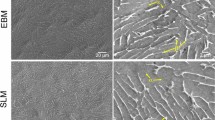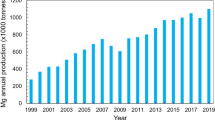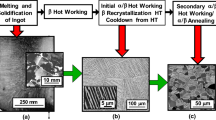The effect of a tensile stress during electric pulse heat treatment on crystal structure formation in amorphous rapidly hardened Ti50Ni25Cu25 alloys is studied. Amorphous ribbons are subjected to a 10-msec electric pulse treatment in a free condition and under a tensile stress of 5.9 and 29.7 MPa. Specimen structure is studied by optical and scanning electron microscopy, energy dispersive analysis, and differential scanning calorimetry. It is shown that amorphous ribbon crystallization under electric pulse treatment with a tensile load occurs primarily due to growth of surface columnar crystals from the ribbon surface into the depth and then from the internal part of a ribbon due to spherulite formation and growth.






Similar content being viewed by others
References
K. Otsuka and X. Ren, “Physical metallurgy of Ti – Ni-based shape memory alloys,” Prog. Mater. Sci., No. 50, 511 – 678 (2005).
Q. Sun, R. Matsui, K. Takeda, et al., Advances in Shape Memory Materials, Springer Int. Pub. AG, Berlin (2017).
J. M. Jani, M. Leary, A. Subic, et al., “A review of shape memory alloy research, applications and opportunities,” Material Design, No. 56, 1078 – 1113 (2014).
T. H. Nam, T. Saburi, and K. Shimizu, “Cu-content dependence of shape memory characteristics in Ti – Ni – Cu alloys,” Mater. Trans. JIM, No. 31, 959 – 967(1990).
N. Choudhary and D. Kaur, “Shape memory alloy thin films and heterostructures for MEMS applications: A review,” Sensors Actuators A: Physical, No. 242, 162 – 181 (2016).
S. Kumara and M. Lakshmi, “Shape memory alloys and its application in mems devices,” Int. J. Current Eng. Technol., No. 3(2), 292 – 296 (2013).
A. Nespoli, S. Besseghini, S. Pittaccio, E. Villa, and S. Viscuso, “The high potential of shape memory alloys in developing miniature mechanical devices: A review on shape memory alloy miniactuators,” Sensors Actuators A: Physical, No. 158(1), 149 – 160 (2010).
N. Sitnikov, A. Shelyakov, R. Rizakhanov, et al., “The effect of copper on structure of TiNiCu melt-spun ribbons,” Mater. Today:Proc., No. 4, 4680 – 4684 (2017).
B. C. L. Pedro and A. S. Marcelo, “Shape memory alloy-based mechanism for aeronautical application: Theory, optimization and experiment,” Aerospace Sci. Technol., No. 76, 155 – 163 (2018).
W.-S. Chang and Y. Araki, “Use of shape memory alloy in construction: a critical review,” Proc. ICE-Civil Eng., No. 169, 87 – 95 (2016).
A. I. Razov, “Application of titanium nickelide-based alloys in engineering,” Phys. Met. Metallogr., No. 97(1), 97 – 126 (2004).
A. V. Shelyakov, N. N. Sitnikov, A. P. Menushenkov, et al., “Formation of an inverse shape memory effect in TiNiCu alloys by spinning,” Izv. Ross. Akad. Nauk, Ser. Fiz., 79(9), 1281 – 1287 (2015).
H. Conrad, “Effects of electric current on solid state phase transformations in metals,” Mater. Sci. Eng. A, No. 287, 227 – 237 (2000).
Y. Sheng, Y. Hua, X. Wang, et al., “Application of high-density electropulsing to improve the performance of metallic materials: mechanisms, microstructure and properties,” Materials, No. 11(2), 185 – 210 (2018).
A. V. Shelyakov, N. N. Sitnikov, I. A. Khabibullina, et al., “Effect of high-rate annealing on microstructure, martensitic transformation and shape memory behavior of TiNiCu meltspun ribbons,” Mater. Lett., No. 248, 48 – 51 (2019).
A. V. Shelyakov, N. N. Sitnikov, A. P. Menushenkov, et al., “Nanostructured thin ribbons of a shape memory TiNiCu alloy,” Thin Solid Films, No. 519, 5314 – 5317 (2011).
N. N. Sitnikov, A. V. Shelyakov, I. A. Khabibulinna, and R. V. Sundeev, “Featuresof the development of a shape memory effect in alloy Ti50Ni25Cu25 prepared by rapid melt quenching,” Deform. Razrush. Mater., No. 4, 15 – 21 (2017).
I. N. Sitnikov, I. A. Khabibulinna, and A. V. Shelyakov, “Rapid quenching of amorphous crystalline ribbon with a shape memory effect of alloy Ti50Ni25Cu25 for micromechanical devices,” Vektor Nauki TGU, No. 4(42), 125 – 134 (2017).
Work was conducted with support of an RNF grant No. 19-72-00145 (in conducting EPT and studying the amorphous- crystalline state) and RFFI grant No. 18-32-00866\19 (in the calorimetric study section).
Author information
Authors and Affiliations
Corresponding author
Additional information
Translated from Metallovedenie i Termicheskaya Obrabotka Metallov, No. 5, pp. 22 – 28, May, 2021.
Rights and permissions
About this article
Cite this article
Sitnikov, N.N., Zaletova, I.A., Shelyakov, A.V. et al. Study of the Effect of Tensile Stress During Electric Pulse Treatment of Amorphous Rapidly Hardened Ti50Ni25Cu25 Alloys on Crystal Structure Formation. Met Sci Heat Treat 63, 251–257 (2021). https://doi.org/10.1007/s11041-021-00679-5
Published:
Issue Date:
DOI: https://doi.org/10.1007/s11041-021-00679-5




